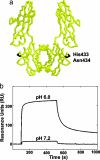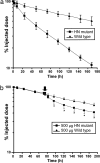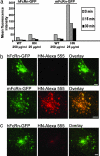Divergent activities of an engineered antibody in murine and human systems have implications for therapeutic antibodies
- PMID: 17116867
- PMCID: PMC1693727
- DOI: 10.1073/pnas.0606304103
Divergent activities of an engineered antibody in murine and human systems have implications for therapeutic antibodies
Abstract
The MHC class I-related receptor, neonatal Fc receptor (FcRn), plays a central role in regulating the transport and in vivo persistence of immunoglobulin G (IgG). IgG-FcRn interactions can be targeted for engineering to modulate the in vivo longevity and transport of an antibody, and this has implications for the successful application of therapeutic IgGs. Although mice are widely used to preclinically test antibodies, human and mouse FcRn have significant differences in binding specificity. Here we show that an engineered human IgG1 has disparate properties in murine and human systems. The mutant shows improved transport relative to wild-type human IgG1 in assays of human FcRn function but has short in vivo persistence and competitively inhibits FcRn activity in mice. These studies indicate potential limitations of using mice as preclinical models for the analysis of engineered antibodies. Alternative assays are proposed that serve as indicators of the properties of IgGs in humans.
Conflict of interest statement
Conflict of interest statement: There is a pending patent that describes the mutated human IgG1 used in the studies.
Figures




Similar articles
-
Neonatal Fc receptor (FcRn): a novel target for therapeutic antibodies and antibody engineering.J Drug Target. 2014 May;22(4):269-78. doi: 10.3109/1061186X.2013.875030. Epub 2014 Jan 9. J Drug Target. 2014. PMID: 24404896 Review.
-
Engineering the Fc region of immunoglobulin G to modulate in vivo antibody levels.Nat Biotechnol. 2005 Oct;23(10):1283-8. doi: 10.1038/nbt1143. Epub 2005 Sep 25. Nat Biotechnol. 2005. PMID: 16186811
-
Combined glyco- and protein-Fc engineering simultaneously enhance cytotoxicity and half-life of a therapeutic antibody.MAbs. 2014 Mar-Apr;6(2):422-36. doi: 10.4161/mabs.27854. Epub 2014 Jan 15. MAbs. 2014. PMID: 24492301 Free PMC article.
-
Cross-species analysis of Fc engineered anti-Lewis-Y human IgG1 variants in human neonatal receptor transgenic mice reveal importance of S254 and Y436 in binding human neonatal Fc receptor.MAbs. 2016 May-Jun;8(4):775-86. doi: 10.1080/19420862.2016.1156285. Epub 2016 Mar 30. MAbs. 2016. PMID: 27030023 Free PMC article.
-
Targeting FcRn for the modulation of antibody dynamics.Mol Immunol. 2015 Oct;67(2 Pt A):131-41. doi: 10.1016/j.molimm.2015.02.007. Epub 2015 Mar 9. Mol Immunol. 2015. PMID: 25766596 Free PMC article. Review.
Cited by
-
Impact of structural modifications of IgG antibodies on effector functions.Front Immunol. 2024 Jan 8;14:1304365. doi: 10.3389/fimmu.2023.1304365. eCollection 2023. Front Immunol. 2024. PMID: 38259472 Free PMC article. Review.
-
Fc-fusion proteins and FcRn: structural insights for longer-lasting and more effective therapeutics.Crit Rev Biotechnol. 2015 Jun;35(2):235-54. doi: 10.3109/07388551.2013.834293. Epub 2013 Oct 24. Crit Rev Biotechnol. 2015. PMID: 24156398 Free PMC article. Review.
-
Phagocytosis of antibody-opsonized tumor cells leads to the formation of a discrete vacuolar compartment in macrophages.Traffic. 2018 Apr;19(4):273-284. doi: 10.1111/tra.12552. Traffic. 2018. PMID: 29437282 Free PMC article.
-
Fc-Engineering for Modulated Effector Functions-Improving Antibodies for Cancer Treatment.Antibodies (Basel). 2020 Nov 17;9(4):64. doi: 10.3390/antib9040064. Antibodies (Basel). 2020. PMID: 33212886 Free PMC article. Review.
-
The Neonatal Fc Receptor (FcRn): A Misnomer?Front Immunol. 2019 Jul 10;10:1540. doi: 10.3389/fimmu.2019.01540. eCollection 2019. Front Immunol. 2019. PMID: 31354709 Free PMC article. Review.
References
-
- Ghetie V, Popov S, Borvak J, Radu C, Matesoi D, Medesan C, Ober RJ, Ward ES. Nat Biotechnol. 1997;15:637–640. - PubMed
-
- Shields RL, Namenuk AK, Hong K, Meng YG, Rae J, Briggs J, Xie D, Lai J, Stadlen A, Li B, et al. J Biol Chem. 2001;276:6591–6604. - PubMed
-
- Dall'Acqua W, Woods RM, Ward ES, Palaszynski SR, Patel NK, Brewah YA, Wu H, Kiener PA, Langermann S. J Immunol. 2002;169:5171–5180. - PubMed
-
- Hinton PR, Johlfs MG, Xiong JM, Hanestad K, Ong KC, Bullock C, Keller S, Tang MT, Tso JY, Vasquez M, et al. J Biol Chem. 2004;279:6213–6216. - PubMed
Publication types
MeSH terms
Substances
Grants and funding
LinkOut - more resources
Full Text Sources
Other Literature Sources
Research Materials

